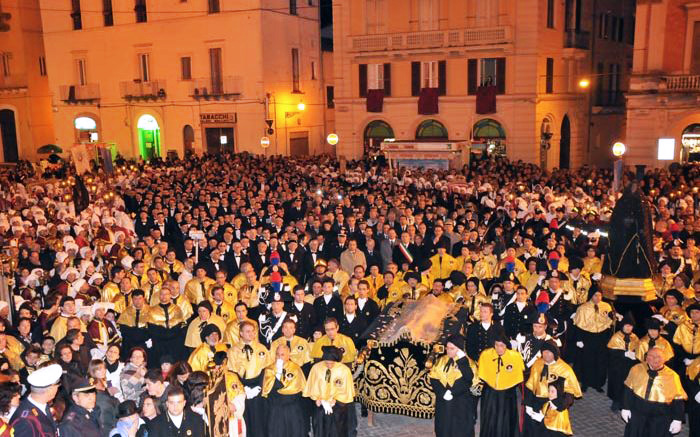The Oldest Religious Festival in Italy
In a country that teems with religious festivals all year long, it is quite a feat to be named the oldest in all of Italy. What is even more impressive is to also be named the most emotional procession at the holiest and most solemn time of the year. The only event that can lay claim to all of these titles is La Processione del Venerdì Santo, a Good Friday procession that takes place in the Abruzzese town of Chieti.
Pasqua, or Easter, is perhaps the most celebrated holiday in Italy. During Settimana Santa (Holy Week), tributes take place across the country. However, those in Abruzzo seem to provide an added touch of drama that makes the ceremonies and festivals all the more memorable. In no place in Abruzzo is this more apparent than in Chieti, where a touching spectacle occurs that is powerful enough to bring crowds of tens of thousands to tears.
La processione del Venerdì Santo lays claim to the title as the oldest religious festival by virtue of its origin 1,177 years ago in 842. The present form of the solemn Easter procession dates to the 18th century, by the Arciconfraternita del Sacro Monte dei Morti. The ancient brotherhood has organized the event each year ever since, even during Italy’s most troubling times. During World War II, the occupying German army prohibited the town from holding the event, yet against all odds, the group went ahead with this sacred custom.
Each year on Good Friday, locals gather in the main piazza where they wait patiently, until, at precisely 7:00 pm, the procession starts from the Cathedral San Giustina. One of the most remarkable things about the moment is that at 6:59 pm, many thousands of people will be chatting with one another and the crowd’s noise inescapable; yet one minute later, the sudden quiet that befalls the crowd is like a radio that is quickly switched off. It is as though even crying infants realize the importance of reverent silence.
The procession is formed by members of the Sacro Monte dei Morti, identifiable by their black and gold trimmed satin capes. The faithful gather in clusters to represent each of the town’s church congregations, with every group wearing a distinct colored robe. All of the participants wear hoods as a way of protecting their personal mourning, grief, penance and prayers. In fact, the word Capuchin (monk) originally stemmed from this tradition, arising out of the Italian word for “hood” – cappuccio.
Each congregation walks to the rhythm of a troccola, a wooden instrument that traditionally replaces bells throughout Holy Week. Interspersed among the groups of people are the brotherhood carrying the Stations of the Cross, as well as a rooster, a hand, spears, a figure of the mourning Mary robed in black and a statue of the covered Christ. The congregation is followed by the Archbishop and local priests who stop intermittently to recite a liturgy and prayers, as they make their way back to the cathedral.
Perhaps the most touching moment of the entire spectacle is saved for last, when an orchestra of 100 violinists, many of whom are children, play “Miserere,” an 18th century, ten stanza melancholic piece by Saverio Selecchi, who was from Chieti. The musicians are accompanied by a 100 member choir, whose poignant singing moves the crowd to tears. Legend has it that this emotional event inspired Verdi to write his tragic opera ‘ll Trovatore.’
Devoted followers have maintained the ritual, not for the sake of tradition, but because of what it signifies. To behold the event is truly a humbling experience that puts this most holy time of the year into perspective.





